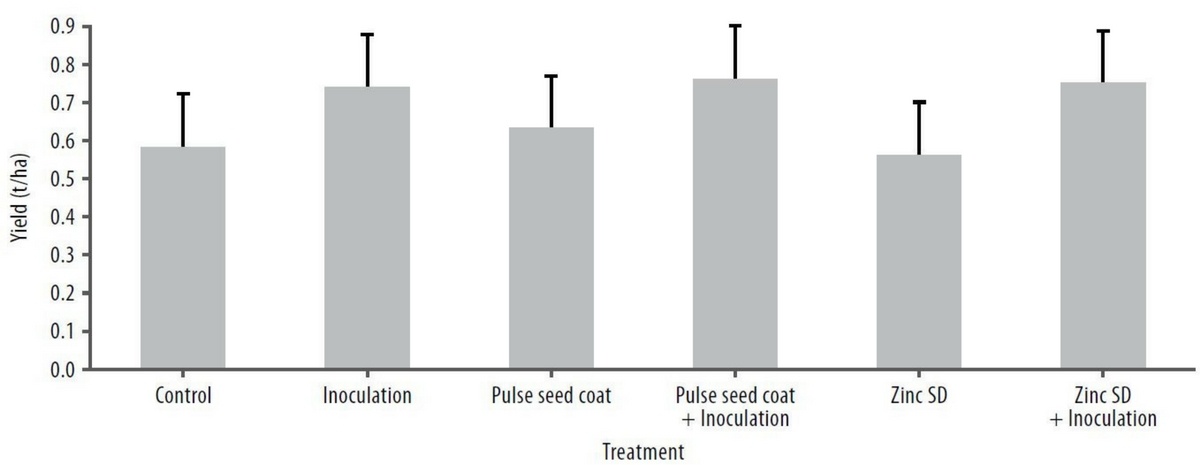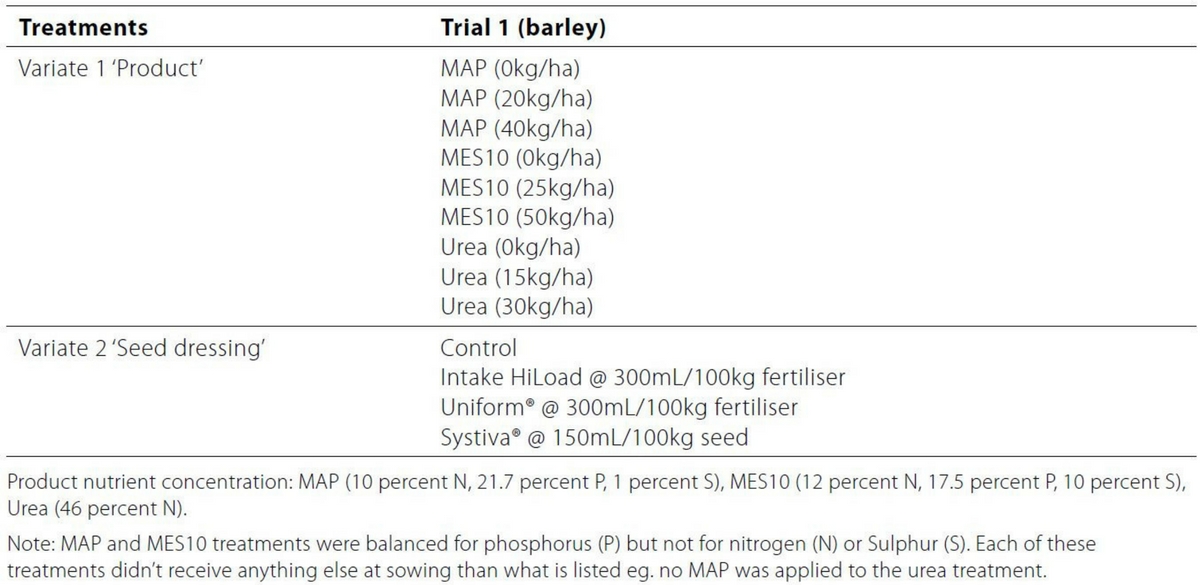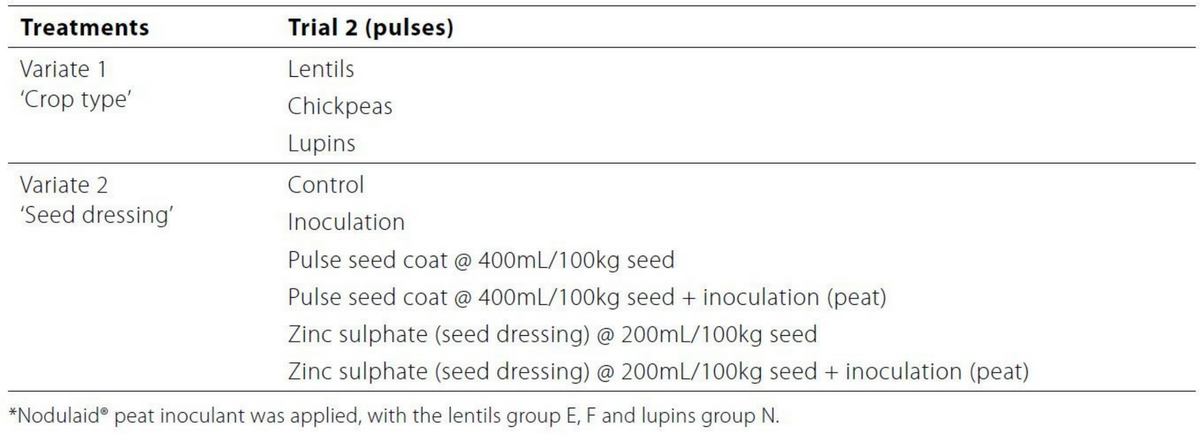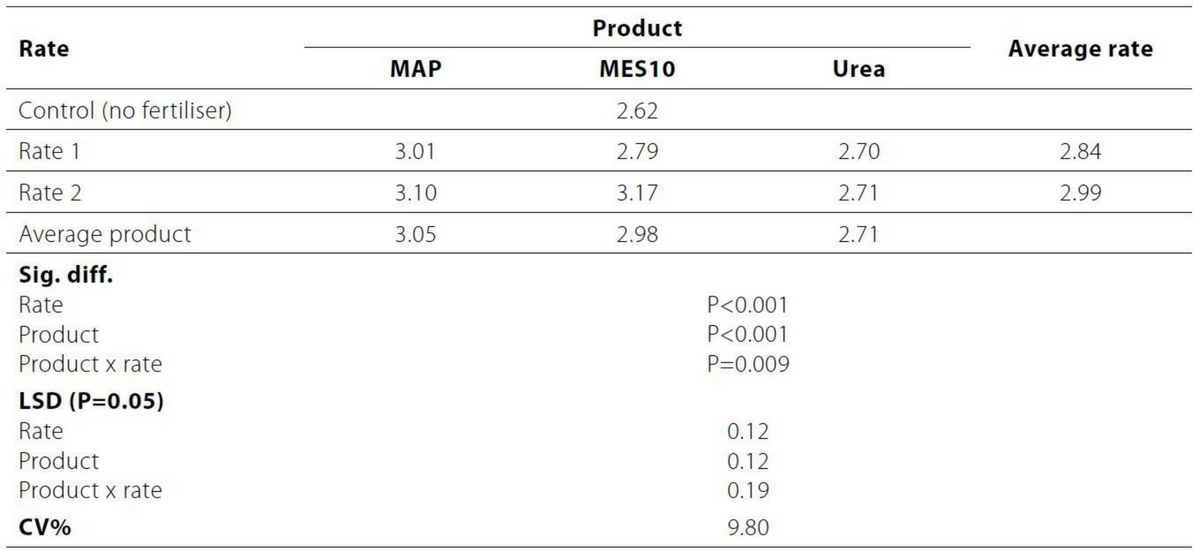Take home messages
- The addition of fungicidal seed treatments did not improve the yield of barley (mean yield 2.8t/ha). Applying more fertiliser, regardless of the product had a significant improvement in the yield of barley. Therefore, dollars should be spent on fertilisers more so than seed dressings.
- There was a significant response to inoculation in chickpeas but not in lentils or lupins. There was no yield benefit in applying zinc or pulse seed coat to seed at sowing.
- Chickpea gross margin ($574/ha), followed by barley ($444/ha) was the most profitable crop grown on the site.
Background
As we continue to look and explore new opportunities, over the past three seasons, growers have begun to grow more lucrative pulse crops such as lentils and chickpeas on soil types that were once considered unsuitable. Mallee sand hills, since 2010, appeared to be less reliable than they once were. Dry winters, coupled with higher temperatures particularly in August, have not favoured crop growth during this period. Nevertheless, with stubble retention, growers are gaining confidence to sow crop types such as lentils on these soils without having the risk of wind erosion.
With the recent seasons being fortunate in both production and profitability of pulses compared to cereals; lentils and chickpeas have been quite lucrative and have provided growers with a valuable ‘break’ from the cereal dominant rotations. For many years, lupins were used as a break on these soil types, but several years of poor performances have resulted in these other ‘higher risk’ crop types being sown.
Due to the increased production risk, growers and advisors have been exploring different fertiliser and seed dressing strategies in order to promote the establishment and yield of these crops. Through funding provided under the National Landcare Programme (Project code: 4-3HSQACL), the Kooloonong-Natya Landcare group with the assistance of BCG, explored specific management for barley, lentils, chickpeas and lupins. The article will report on the findings from the project.
Aim
To determine specific inputs growers can use to improve crop production of barley, lentils, chickpeas and lupins on sand hills in the Mallee.
Paddock details
| Location: | Kooloonong |
| GSR (Apr-Oct): | 177.2mm |
| Soil type: | Red sand |
| Paddock history: | 2014 vetch, 2015 wheat, 2016 wheat |
Trial details
| Crop types: | Spartacus CL barley, Hurricane XT lentils, Genesis 090 chickpeas and Mandelup lupins |
| Treatments: | Refer to Tables 1 and 2 |
| Seeding equipment: | Knife points, press wheels, 30cm row spacing |
| Sowing date: | 4 May 2017 |
| Plot replication: | Four |
| Harvest date: | 19 November 2017 |
| Trial average yield: | Barley – 2.8t/ha |
Trial inputs
| Fertiliser: pulses | Granulock Supreme Z @ 60kg/ha + Intake® HiLoad @ 2L/t applied to seed at sowing. |
| Fertiliser: barley | See treatment list (Table 1) Urea @ 45kg/ha at 3-4 leaf and urea @ 90kg/ha at 1st node stage |
| Pests and disease were controlled as required. No weeds or pests affected the trial during the season. | |
Table 1. Barley treatment list for the trial.
Table 2. Pulse treatment list for the trial.
Method
Two replicated field trials were sown into a standing wheat stubble at Kooloonong in 2017. The site was chosen based on the heightened risk of root and stubble borne diseases having been wheat-on-wheat for the previous two seasons.
The first trial compared different fertiliser products at different rates and seed dressings in barley. The second trial investigated six seed dressing treatments on three pulse crop types – lentils, chickpeas and lupins.
Both trials were designed using a two-way randomised block design. Each trial compared the use of specific seed dressings or additives applied at sowing that growers and advisors have seen anecdotal benefits.
In-season assessments included crop biomass using a normalised difference vegetative index (NDVI) with a handheld GreenSeeker® crop sensor, and grain yield and quality parameters.
Results and interpretation
Barley
Upon the first NDVI assessment from 11 July, there were slightly healthier plants identified by the Greenseeker®. As the Greenseeker® can detect higher plant biomass or greater chlorophyll content based on the crop reflectance, simply if the treatment had a higher NDVI reading the plant is healthier or has responded positively to the application. Uniform® was the only treatment to have been significantly higher than the control, but only marginally. A follow up NDVI assessment was made on 20 July. No difference between any of the treatments were identified. This would suggest the benefit was marginal, however it should be noted that there were several frosts that occurred during July which did appear to affect the crop growth, albeit not specific to treatments.
In terms of grain yield, there was no significant difference found between any of the treatments. The mean grain yield for the trial was 2.8t/ha. There was also little difference identified in grain quality with the exception of retention, which found Uniform to have strangely a lower retention compared to the control and Systiva (Table 3). All treatments due to screenings fell into the Feed 1 grade.
Table 3. Grain yield and quality parameters for the seed dressing treatments in barley.
The fertiliser products used in this trial were chosen specifically to determine which nutrients were most important on this soil type. Urea (46% N) as we all know contains only N, therefore any response to the addition of this product would suggest N was limiting. MAP and MES10 were balanced in terms of P but not N or S. There is slightly more N applied under the MES10 treatment (1 and 2kg N/ha respectively for the different rates) but the principal difference between these products is the addition of S. Responses to S have been reported in the Mallee and for some years growers have been using this product to ensure S is not limiting crop yield. Again, it should be noted that a percentage of this S applied is present as elemental S, which in these soils may not be available to the crop until much later in the season, if not until seasons later.
The initial NDVI reading found a significant interaction between the product and rate of the different fertiliser treatments. Across all treatments there was a positive response to the addition of fertiliser and to a lesser extent, increasing the rate (Table 4). After the initial amount of N applied in 15kg/ha urea in Rate 1, there was no further yield benefit at the higher rate. The most incremental gain was observed in MES10 and MAP treatments.
Table 4. Grain yield (t/ha) and rate for the fertiliser treatments in barley.
In terms of grain quality, as reported earlier in the article, all treatments were classified as Feed 1, however interesting differences occurred with increased screenings being observed in plots that had received more P compared to those that didn’t (P<0.001). This trend was also observed in retention as well. Whilst it is uncertain why this occurred exactly, possibly due to the frost events there was some secondary tillers that failed to fill during grain filling. Therefore, increasing screenings would reduce retention as well. There was no significant difference found in grain protein and test weight.
Pulses
The site had not grown any of these crop types, albeit having vetch hay in 2014. The rhizobia for vetch falls under a different group to lentils, lupins and chickpeas, although most vetch inoculants contain group F (lentil inoculant). Depending on the weeds that persisted, there could have been a natural rhizobia present in the soil, reducing the likelihood of responses in lentils. Nevertheless, it would be fair to expect the value of inoculation would be pronounced in these trials than those in normal crop sequences.
At harvest, there was no difference in any of the treatments in either the lentils or lupins trial whilst in the chickpeas, there was a strong response to inoculation (Table 5). All chickpea treatments that were inoculated were significantly higher than the control and uninoculated treatments (Figure 1). This has been supported by previous BCG research.
The addition of zinc and the pulse seed coat failed to have a significant improvement on grain yield for any of the crop types.
Table 5. Grain yield of chickpeas, lentils and lupins in response to the treatments.

Commercial practice
The results of these trials suggest growers should ensure proper nutrition prior to investing in other inputs such as seed treatments. Systiva, flutriafol and Uniform are unique and valuable products, especially in situations where the risk of root and stubble borne diseases are high. Nevertheless, at this site and environment, there was no response to their application, so the investment into these products was unwarranted.
The performance of the pulses was surprising given the season. The benefits of pulse crops to subsequent rotations stretches beyond just the one season so it is always difficult to compare. Growers should be optimistic about the performance of pulses in this trial and recent years, and should continue to explore their suitability on different soil types. However, keeping the costs down by not investing in inputs that do not have a proven value will be a way to mitigate some of the risk of growing them.
On-farm profitability
This trial found that chickpeas were the most profitable crop to grow in 2017, followed closely by barley. Favourable chickpea prices were a significant factor in driving this profitability. Note: these figures were calculated based on no additional inputs which did not have a positive response to yield being included. Adding these inputs would only have increased the input cost and thus reduced the gross margin by the cost of the product.
Table 6. Partial gross margin for the specific crop types used in this trial.
Acknowledgements
These trials were funded by National Landcare Programme ‘25th Anniversary Grants’.






